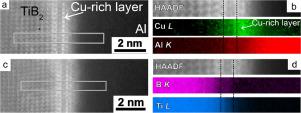Acta Materialia ( IF 9.4 ) Pub Date : 2021-01-15 , DOI: 10.1016/j.actamat.2021.116652 Jiehua Li , Fredrik S. Hage , Quentin M. Ramasse , Peter Schumacher

|
The refinement of Al alloys by TiB2 has been extensively investigated for decades, both in industry and academia. In order to achieve higher grain refinement potency, it is known that other solutes must be added alongside TiB2, thus tailoring the heterogeneous nucleation at the interface between the TiB2 particles and the Al matrix. Here, we report results from an atomic-scale experimental investigation of the heterogeneous nucleation interface of TiB2 in Al-Cu based alloys as well as in an Al-5Ti-1B grain refiner employed in these Al-Cu based alloys. We focus on the effect of segregation of the main solute elements (Ti, Cu) to the interface of TiB2 and attempt to disentangle this effect from other factors affecting the nucleation and growth. Significant Ti segregation in the form of a Ti-rich layer, identified as an Al3Ti two-dimensional compound, was unambiguously observed on the basal plane of TiB2 particles in the Al-5Ti-1B grain refiner, in agreement with prior literature. In the Al-Cu alloy system, prevalent Ti segregation was also observed on the basal plane of TiB2, accompanied in cases when the Cu concentration is high by the presence of a further atomic-scale Cu-rich layer. Based on these observations, a possible nucleation sequence for the Al-Cu based alloys with the addition of Al-5Ti-1B grain refiner is proposed whereby Al nucleation occurs on an Ti-rich layer on the surface of TiB2, which can then be preserved from a subsequent peritectic transformation by a surrounding eutectic reaction that forms a Cu-rich layer when sufficient Cu is present. This proposed nucleation sequence should help to link the absence or presence of Al3Ti layers on the basal plane of TiB2 to processing conditions in post-solidification studies. Although it is difficult to know with absolute certainty if a TiB2 particle observed in the post-solidification microstructure was active or inactive for heterogeneous nucleation during the solidification process, this experimental study highlights the possible role of Cu segregation on grain refinement of Al-Cu alloys by the Al-5Ti-1B grain refiner.
中文翻译:

Al-Cu合金中TiB 2颗粒上α-Al的成核顺序
数十年来,在工业界和学术界都广泛研究了用TiB 2精炼铝合金。为了获得更高的晶粒细化能力,已知必须在TiB 2旁边添加其他溶质,从而在TiB 2颗粒和Al基体之间的界面处调整异相形核。在这里,我们报告了从原子尺度的实验研究结果得出的TiB 2在Al-Cu基合金以及在这些Al-Cu基合金中使用的Al-5Ti-1B晶粒细化剂的异质成核界面的结果。我们关注于主要溶质元素(Ti,Cu)向TiB 2界面偏析的影响并试图将这种影响与影响成核和生长的其他因素区分开。在Al-5Ti-1B晶粒细化机中,在TiB 2颗粒的基面上清晰地观察到了富钛层形式的大量Ti偏析,被识别为Al 3 Ti二维化合物。。在Al-Cu合金体系中,在TiB 2的基面上还观察到普遍的Ti偏析,伴随着另外一个原子级富Cu层的存在,当Cu浓度很高时。基于这些观察,提出了添加Al-5Ti-1B晶粒细化剂的Al-Cu基合金可能的成核顺序,从而Al形核发生在TiB表面富钛层上如图2所示,然后可以通过周围的共晶反应来防止随后的包晶转变,当存在足够的Cu时,该共晶反应形成富Cu层。拟议的成核顺序应有助于将TiB 2基面上Al 3 Ti层的不存在与存在联系起来,以进行后凝固研究。尽管很难绝对确定在凝固后微观结构中观察到的TiB 2颗粒是活跃的还是不活跃的,但对于凝固过程中的异相形核,本实验研究强调了铜偏析对Al-Cu晶粒细化的可能作用合金由Al-5Ti-1B晶粒细化剂制成。


























 京公网安备 11010802027423号
京公网安备 11010802027423号